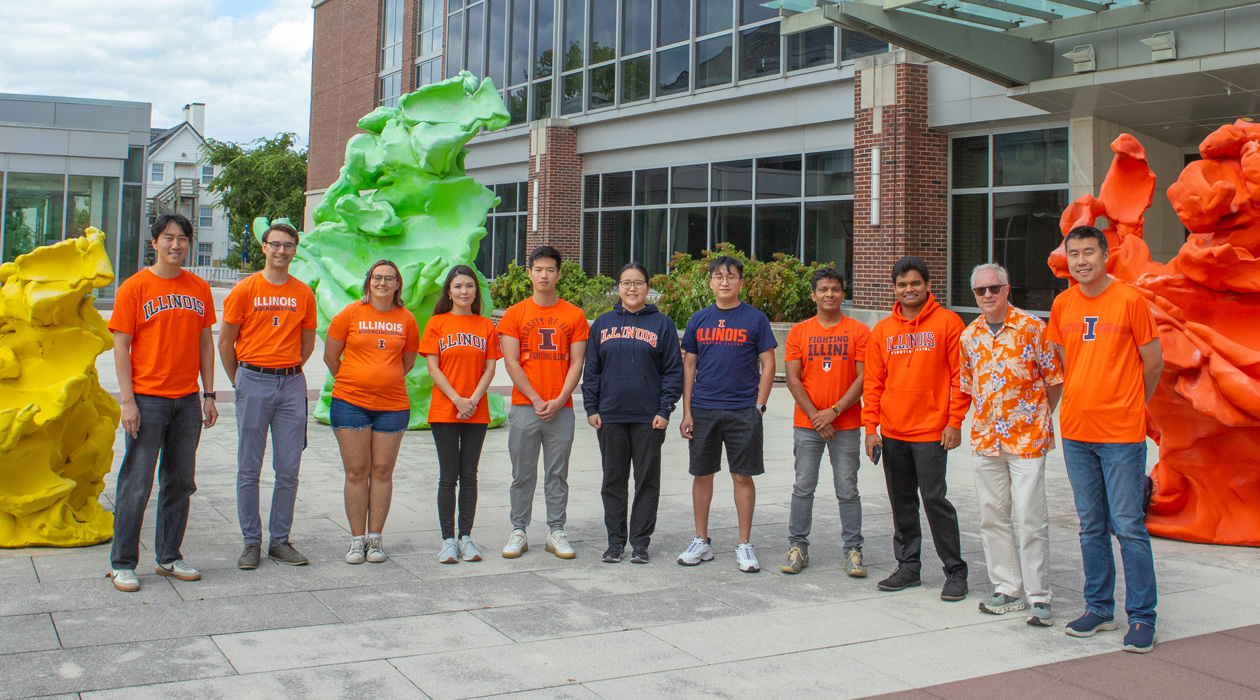This October, a team of scientists at the Carl R. Woese Institute for Genomic Biology (IGB), University of Illinois Urbana-Champaign (UIUC), gathered for a group photo. Dressed in bright Illini orange and blue, they weren’t just celebrating a paper; they were celebrating a shared journey.

The team emphasized their teamwork effort by wearing Illini Orange and Blue.
[Photo credit: Isaac Mitchell. Reprinted from Brady (2025)]
Among them are Prof. Brian Cunningham and Assoc. Prof. Xing Wang, who not only lead research groups at UIUC, but also serves as Principal Investigators at the VinUni–Illinois Smart Health Center (VISHC).
Their review, published in Chemical Reviews and titled “Photonic Crystal Grating Resonance and Interfaces for Health Diagnostic Technologies,” looks at how light-based technologies can help clinicians see what the eye cannot – and how this might shape the future of diagnostics.
Diagnostic tests are now a routine part of modern healthcare, from virus detection to cancer screening. Behind many of these tests is a simple idea: if we can detect tiny biological molecules called biomarkers more clearly and more sensitively, we can see disease earlier and treat it better.
The new review, titled “Photonic Crystal Grating Resonance and Interfaces for Health Diagnostic Technologies,” looks at one of the most promising tools for this goal: PCGR-based biosensors.
The article traces more than 100 years of research. It goes back to early reports of grating photonic substrates in the early 1900s and follows the field through key milestones in 1907, 1947, 1956, and beyond. Over time, simple optical structures evolved into sophisticated photonic crystal gratings, carefully engineered materials that can control how light is absorbed and reflected at the nanoscale.
These structures are especially powerful for diagnostics because they can boost the signals that biosensors rely on. In practice, this means they can help reveal extremely low concentrations of molecules, such as proteins, viruses, or nucleic acids, that may signal disease long before symptoms appear.
The review does something rare: it acts as both a history book and a roadmap.
On one hand, it brings together insights from over 100 published studies, organizing them into clear tables and figures. One of the tables, for example, summarizes two decades of progress in one-dimensional photonic crystal technologies for diagnostics. For researchers just entering the field, this is like having an “encyclopedia” of who did what, when, and how those ideas connect.
On the other hand, the article looks ahead. The authors highlight:
By combining technical background, practical applications, and honest discussion of current limitations, the review invites the scientific community to think together about what needs to happen next.
What started as a modest idea quickly grew into a large team effort. Bhaskar and Cunningham realized that exploring the technical background and applications of PCGR required many different voices. The team included experts in photonics, diagnostics, substrate engineering, and machine learning. Because diagnostics is interdisciplinary, they aimed to offer both information and critical analysis. They also highlighted current challenges, like biosensor fabrication limitations and regulatory gaps, to inspire practical solutions.
VISHC was created with the same goal: to promote international collaboration and bring advanced diagnostic technologies closer to patients, with new projects and training programs that bridge countries and disciplines.
Read more at: https://www.igb.illinois.edu/wheeler/article/century-photonics-research-shapes-future-healthcare-diagnostics